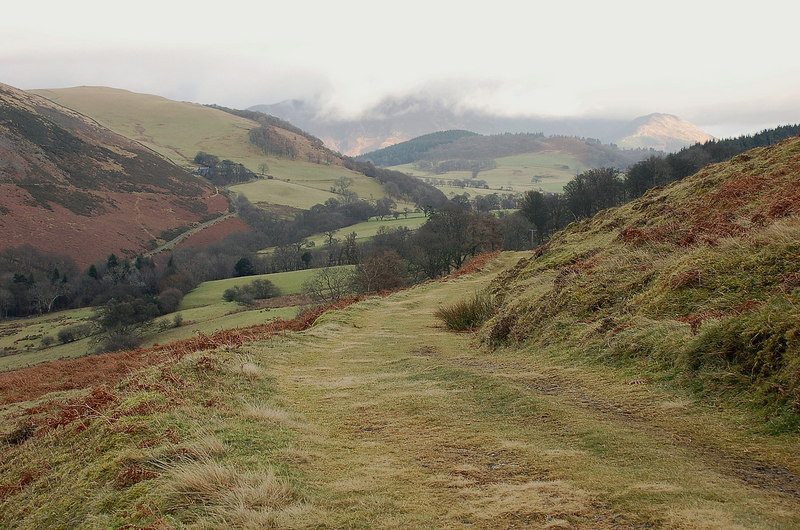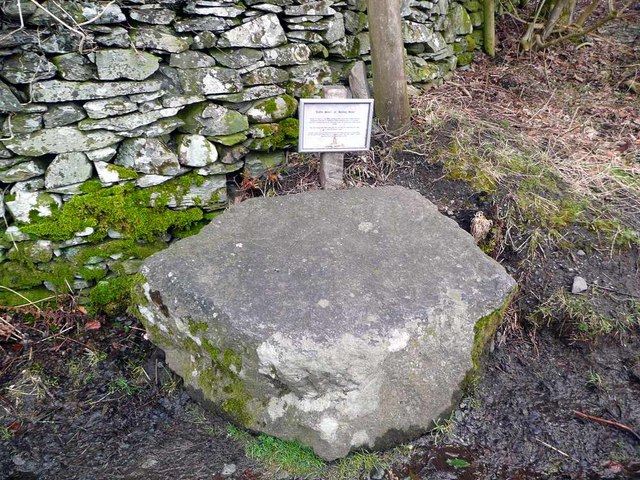Corpse roads, coffin roads or church paths, also called bier roads, lych ways[a]from the Old English lic meaning body and church ways,[1] once provided the means of transporting the dead to churchyards for burial. Once common throughout the country, some survive particularly in rural and remote places.
In medieval times ecclesiastical parishesAncient or ancient ecclesiastical parishes encompassed groups of villages and hamlets and their adjacent lands, over which a clergyman had jurisdiction. were large, often encompassing several townshipsDivision of an ecclesiastical parish that had civil functions.. A single parish church, the mother church, served the entire population for all ritual baptisms, marriages and burials, and only it held burial rights. Some parishioners had to make long journeys to visit the mother church and the deceased had to be transported long distances for burial. Their corpses were carried along the corpse roads or paths left unploughed.[1]
When daughter churches were built and granted burial rights, corpse roads became obsolete. Many have disappeared or are footpaths the original purpose has been forgotten, but fields crossed by such paths might have names mentioning the church or kirk. Some are marked on old maps and some survive.[2]
Superstition
Folklore and superstition emerged in various localities from the early modern period until the 18th and 19th centuries.[3] They attracted tales of ghosts, wraiths and spirits. While transporting a corpse for burial it was considered bad luck to use alternative routes to the cemetery. Corpses were moved with their feet facing away from their houses to prevent their spirits returning to haunt the living.[4]
An early literary mention in Shakespeare’s “A Midsummer Night’s Dream” alludes to the spiritual plane they inhabit, in the words of Puck:[1][5]
Examples
Before 1580, when the church was built in Muker, the deceased from remote Swaledale were carried many miles to Grinton. The corpse road is now a bridleway across the flanks of Kisdon Fell between Keld and Muker. At Ivelet Bridge is a flat stone on which coffins were rested and a local legend tells of a headless black dog that has been seen here.[6]
In the Middle Ages the parish of Lydford included much of Dartmoor. Locals who lived in remote places had to walk across the moorlandDominant landscape of Britain's uplands, including many of its national parks. to St Petroc’s Church. The 12-mile Lych Way from Bellever crosses over the the moor and ancient woodland to the church.[6]
Several coffin routes cross the Lakeland fells, part of the Buttermere to Lamplugh corpse road passes above the western shore of Loweswater and Holme Force waterfall.[6]
In Scotland, St Dubhthach’s Church at the eastern end of Loch Duich, was the burial place of people from Glen Strathfarrar. A six-mile length of the coffin route through Dorusduain Wood and Bealach na Sròine pass the Falls of Glomach. The former coffin road from Glen Falloch to the old church in Balquhidder, where the 18th-century Scottish outlaw Rob Roy is buried, passes over difficult terrain and is more than nine miles (14 km) long.[7] In South Wales, the Beacons Way follows a coffin route past the Bronze Age burial cairn at Carnau’r Garreg Las.[6]


